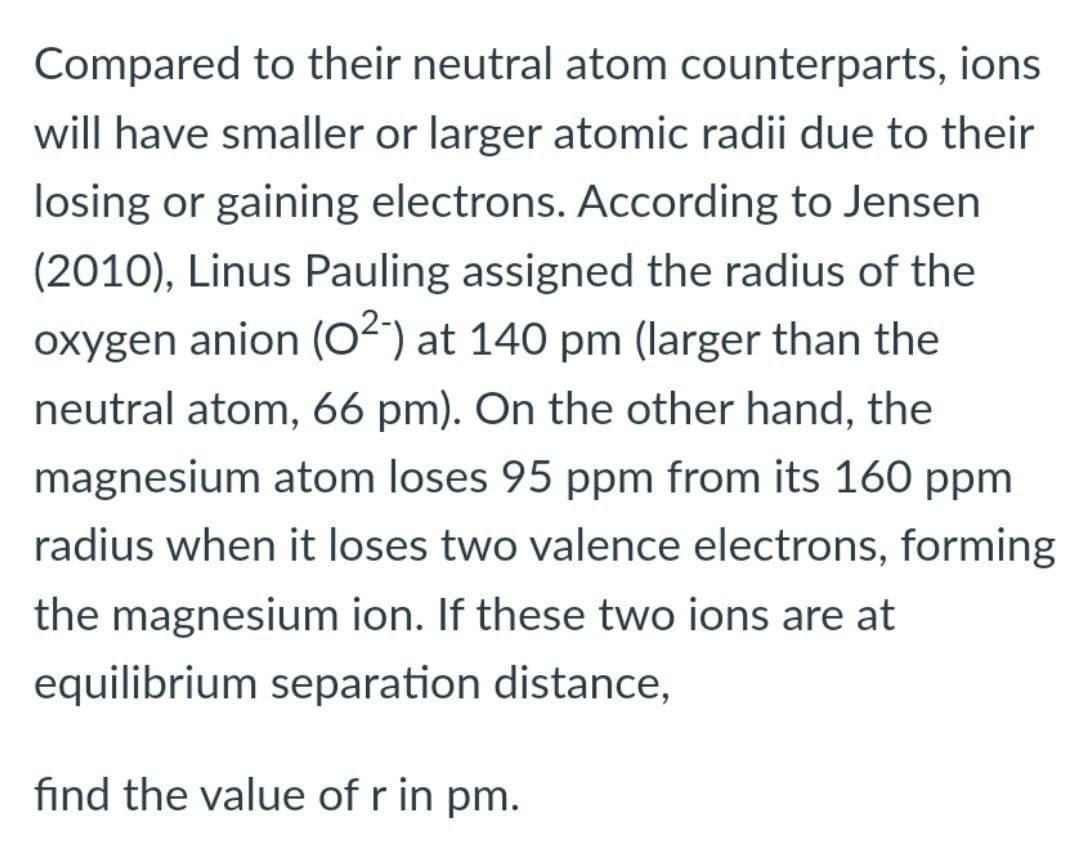Compared to their neutral atom counterparts, ions will have smaller or larger atomic radii due to their losing or gaining electrons. According to Jensen (2010), Linus Pauling assigned the radius of the oxygen anion (O2) at 140 pm (larger than the neutral atom, 66 pm). On the other hand, the magnesium atom loses 95 ppm from its 160 ppm radius when it loses two valence electrons, forming the magnesium ion. If these two ions are at equilibrium separation distance, find the value of r in pm.
Compared to their neutral atom counterparts, ions will have smaller or larger atomic radii due to their losing or gaining electrons. According to Jensen (2010), Linus Pauling assigned the radius of the oxygen anion (O2) at 140 pm (larger than the neutral atom, 66 pm). On the other hand, the magnesium atom loses 95 ppm from its 160 ppm radius when it loses two valence electrons, forming the magnesium ion. If these two ions are at equilibrium separation distance, find the value of r in pm.
Chemistry: Matter and Change
1st Edition
ISBN:9780078746376
Author:Dinah Zike, Laurel Dingrando, Nicholas Hainen, Cheryl Wistrom
Publisher:Dinah Zike, Laurel Dingrando, Nicholas Hainen, Cheryl Wistrom
Chapter6: The Periodic Table And Periodic Law
Section: Chapter Questions
Problem 66A
Related questions
Question

Transcribed Image Text:Compared to their neutral atom counterparts, ions
will have smaller or larger atomic radii due to their
losing or gaining electrons. According to Jensen
(2010), Linus Pauling assigned the radius of the
oxygen anion (O“) at 140 pm (larger than the
neutral atom, 66 pm). On the other hand, the
magnesium atom loses 95 ppm from its 160 ppm
radius when it loses two valence electrons, forming
the magnesium ion. If these two ions are at
equilibrium separation distance,
find the value of r in pm.
Expert Solution
This question has been solved!
Explore an expertly crafted, step-by-step solution for a thorough understanding of key concepts.
This is a popular solution!
Trending now
This is a popular solution!
Step by step
Solved in 2 steps with 2 images

Knowledge Booster
Learn more about
Need a deep-dive on the concept behind this application? Look no further. Learn more about this topic, chemistry and related others by exploring similar questions and additional content below.Recommended textbooks for you

Chemistry: Matter and Change
Chemistry
ISBN:
9780078746376
Author:
Dinah Zike, Laurel Dingrando, Nicholas Hainen, Cheryl Wistrom
Publisher:
Glencoe/McGraw-Hill School Pub Co

Chemistry: Principles and Reactions
Chemistry
ISBN:
9781305079373
Author:
William L. Masterton, Cecile N. Hurley
Publisher:
Cengage Learning

Chemistry: An Atoms First Approach
Chemistry
ISBN:
9781305079243
Author:
Steven S. Zumdahl, Susan A. Zumdahl
Publisher:
Cengage Learning

Chemistry: Matter and Change
Chemistry
ISBN:
9780078746376
Author:
Dinah Zike, Laurel Dingrando, Nicholas Hainen, Cheryl Wistrom
Publisher:
Glencoe/McGraw-Hill School Pub Co

Chemistry: Principles and Reactions
Chemistry
ISBN:
9781305079373
Author:
William L. Masterton, Cecile N. Hurley
Publisher:
Cengage Learning

Chemistry: An Atoms First Approach
Chemistry
ISBN:
9781305079243
Author:
Steven S. Zumdahl, Susan A. Zumdahl
Publisher:
Cengage Learning